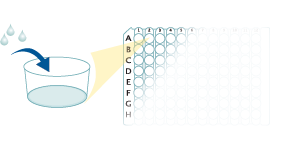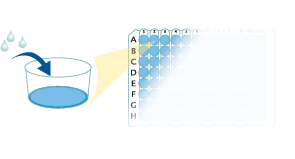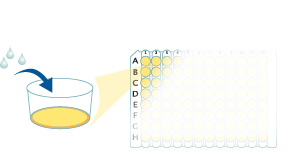Human FABP4 Quantikine ELISA Kit Summary
Product Summary
Precision
Cell Culture Supernates, Cell Lysates, Serum, EDTA Plasma, Heparin Plasma
| Intra-Assay Precision | Inter-Assay Precision | |||||
|---|---|---|---|---|---|---|
| Sample | 1 | 2 | 3 | 1 | 2 | 3 |
| n | 20 | 20 | 20 | 20 | 20 | 20 |
| Mean (pg/mL) | 349 | 1155 | 2595 | 407 | 1236 | 2619 |
| Standard Deviation | 20.2 | 39.7 | 117 | 51.6 | 156 | 291 |
| CV% | 5.8 | 3.4 | 4.5 | 12.7 | 12.6 | 11.1 |
Recovery
The recovery of human FABP4 spiked to levels throughout the range of the assay in various matrices was evaluated.
| Sample Type | Average % Recovery | Range % |
|---|---|---|
| Cell Culture Media (n=4) | 108 | 100-118 |
| Cell Lysis Buffer 1 (n=2) | 108 | 92-117 |
| EDTA Plasma (n=4) | 98 | 88-113 |
| Heparin Plasma (n=4) | 95 | 83-103 |
| Serum (n=4) | 99 | 82-113 |
Linearity
Scientific Data
Preparation and Storage
Background: FABP4/A-FABP
FABP4 (Fatty Acid Binding Protein 4), also known as A-FABP and aP2, is the predominant FABP found in adipocytes and is often used as a marker for adipocyte differentiation. It is also expressed in macrophages, dendritic cells, and endothelial cells. FABP4 is a key mediator of intracellular fatty acid transport and metabolism in adipose tissue. Its expression is regulated by multiple factors including fatty acids, PPAR gamma agonists, and Insulin, and its levels increase with lipolytic stimulation. It can increase the hydrolytic activity of Hormone-Sensitive Lipase and increase the production of proinflammatory cytokines and chemokines. FABP4 upregulation in adipocytes and macrophages is associated with the development of Insulin resistance, hypertriacylglycerolaemia, and atherosclerosis. Serum levels of FABP4 are elevated in obesity and metabolic syndrome, type 2 diabetes, HIV-associated lipodystrophy, polycystic ovary syndrome, nonalcoholic fatty liver disease, atherosclerosis, and acute ischaemic stroke. FABP4 is also overexpressed in multiple cancer types including ovarian, bladder, glioblastoma, and oral, and it may play a role in tumor progression.
Assay Procedure
Refer to the product- Prepare all reagents, standard dilutions, and samples as directed in the product insert.
- Remove excess microplate strips from the plate frame, return them to the foil pouch containing the desiccant pack, and reseal.
- Add 100 µL of Assay Diluent to each well.
- Add 50 µL of Standard, control, or sample to each well. Cover with a plate sealer, and incubate at room temperature for 2 hours.
- Aspirate each well and wash, repeating the process 3 times for a total of 4 washes.
- Add 200 µL of Conjugate to each well. Cover with a new plate sealer, and incubate at room temperature for 2 hours.
- Aspirate and wash 4 times.
- Add 200 µL Substrate Solution to each well. Incubate at room temperature for 30 minutes. PROTECT FROM LIGHT.
- Add 50 µL of Stop Solution to each well. Read at 450 nm within 30 minutes. Set wavelength correction to 540 nm or 570 nm.





Citations for Human FABP4 Quantikine ELISA Kit
R&D Systems personnel manually curate a database that contains references using R&D Systems products. The data collected includes not only links to publications in PubMed, but also provides information about sample types, species, and experimental conditions.
14
Citations: Showing 1 - 10
Filter your results:
Filter by:
-
The tyrosine kinase inhibitor Dasatinib reduces cardiac steatosis and fibrosis in obese, type 2 diabetic mice
Authors: Gu, Y;Avolio, E;Alvino, VV;Thomas, AC;Herman, A;Miller, PJ;Sullivan, N;Faulkner, A;Madeddu, P;
Cardiovascular diabetology
Species: Human
Sample Types: Cell Culture Supernates, Cell Lysates
-
Inflammatory and metabolic markers in relation to outcome of in vitro fertilization in a cohort of predominantly overweight and obese women
Authors: H Svensson, S Einarsson, D Olausson, L Kluge, C Bergh, S Edén, M Lönn, A Thurin-Kje
Scientific Reports, 2022-08-03;12(1):13331.
Species: Human
Sample Types: Serum
-
PET/MRI-Evaluated Activation of Brown Adipose Tissue via Cold Exposure Impacts Lipid Metabolism
Authors: K Miniewska, K Maliszewsk, K Pietrowska, J Godzie?, ? ?abieniec, M Mojsak, A Kr?towski, M Ciborowski
Metabolites, 2022-05-19;12(5):.
Species: Human
Sample Types: Serum
-
The adipokine FABP4 is a key regulator of neonatal glucose homeostasis
Authors: I Ron, RK Lerner, M Rathaus, R Livne, S Ron, E Barhod, R Hemi, A Tirosh, T Strauss, K Ofir, I Goldstein, IM Pessach, A Tirosh
JCI Insight, 2021-10-22;6(20):.
Species: Human
Sample Types: Serum
-
Serum fatty acid-binding protein 4 levels and responses of pancreatic islet &beta-cells and &alpha-cells in patients with type 2 diabetes
Authors: H Wang, J Cao, JB Su, XQ Wang, X Wang, DM Zhang, XH Wang
Diabetology & metabolic syndrome, 2021-06-26;13(1):70.
Species: Human
Sample Types: Serum
-
Determination of FABP4, RBP4 and the MMP-9/NGAL complex in the serum of women with breast cancer
Authors: D Tsakogiann, E Kalogera, F Zagouri, E Zografos, D Balalis, G Bletsa
Oncology Letters, 2020-12-04;21(2):85.
Species: Human
Sample Types: Serum
-
Monounsaturated fat rapidly induces hepatic gluconeogenesis and whole-body insulin resistance
Authors: T Sarabhai, S Kahl, J Szendroedi, DF Markgraf, OP Zaharia, C Barosa, C Herder, F Wickrath, P Bobrov, JH Hwang, JG Jones, M Roden
JCI Insight, 2020-05-21;5(10):.
Species: Human
Sample Types: Serum
-
Plasma Adipokines in Patients Resuscitated from Cardiac Arrest: Difference of Visfatin between Survivors and Nonsurvivors
Authors: YZ Chen, SQ Zhou, YQ Chen, H Peng, YG Zhuang
Dis. Markers, 2020-01-14;2020(0):9608276.
Species: Human
Sample Types: Plasma
-
Comparison of plasma fatty acid binding protein 4 concentration in venous and capillary blood
Authors: S Numao, Y Nagasawa, N Goromaru, S Tamaki
PLoS ONE, 2019-12-11;14(12):e0226374.
Species: Human
Sample Types: Plasma
-
FABP4 in Gestational Diabetes-Association between Mothers and Offspring
Authors: J Patro-Ma?y, M Trojnar, ? Kimber-Tro, R Mierzy?ski, J Bartosiewi, J Oleszczuk, B Leszczy?sk
J Clin Med, 2019-02-27;8(3):.
Species: Human
Sample Types: Serum
-
Development of Versatile Human In Vitro Vascularized Adipose Tissue Model with Serum-Free Angiogenesis and Natural Adipogenesis Induction
Authors: O Huttala, M Palmroth, P Hemminki, T Toimela, T Heinonen, T Ylikomi, JR Sarkanen
Basic Clin. Pharmacol. Toxicol., 2018-04-27;0(0):.
Species: Human
Sample Types: Cell Culture Supernates
-
Partitioning of adipose lipid metabolism by altered expression and function of PPAR isoforms after bariatric surgery
Authors: C Jahansouz, H Xu, AV Hertzel, S Kizy, KA Steen, R Foncea, FJ Serrot, N Kvalheim, G Luthra, K Ewing, DB Leslie, S Ikramuddin, DA Bernlohr
Int J Obes (Lond), 2017-08-14;42(2):139-146.
Species: Human
Sample Types: Serum
-
Adipocyte Fatty-Acid Binding Protein is Overexpressed in Cirrhosis and Correlates with Clinical Outcomes
Authors: I Graupera, M Coll, E Pose, C Elia, S Piano, E Solà, D Blaya, P Huelin, C Solé, R Moreira, G de Prada, N Fabrellas, A Juanola, M Morales-Ru, P Sancho-Bru, C Villanueva, P Ginès
Sci Rep, 2017-05-12;7(1):1829.
Species: Human
Sample Types: Plasma
-
Using Neonatal Skin to Study the Developmental Programming of Aging
Authors: Leryn J Reynolds
Exp. Gerontol, 2016-12-27;0(0):.
Species: Human
Sample Types: Cell Lysates
FAQs
No product specific FAQs exist for this product, however you may
View all ELISA FAQsReviews for Human FABP4 Quantikine ELISA Kit
There are currently no reviews for this product. Be the first to review Human FABP4 Quantikine ELISA Kit and earn rewards!
Have you used Human FABP4 Quantikine ELISA Kit?
Submit a review and receive an Amazon gift card.
$25/€18/£15/$25CAN/¥75 Yuan/¥2500 Yen for a review with an image
$10/€7/£6/$10 CAD/¥70 Yuan/¥1110 Yen for a review without an image





